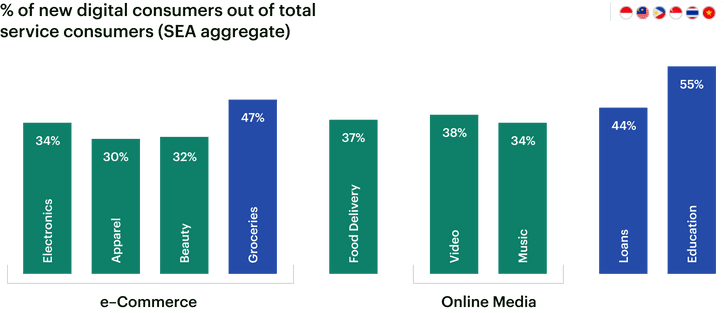The Quantum Leap: How E-Commerce Took the Driver's Seat


Frankie NgLead Hong Kong, Shopify
The accelerated shift to digital commerce triggered by Covid-19 is continuing, as more consumers shop online and entrepreneurs step up to meet demand. These changes in the landscape will endure as consumers' new shopping behaviors stick and become the new normal.
A Decade Forward
The pandemic has accelerated the transformation of retail, essentially pushing Retail in 2020 a decade forward to 2030. E-commerce has truly shown itself to be the engine behind economic growth in the past year, signing up over 30% new digital customers in South-East Asia alone.

Source: E-conomy SEA 2020 Google, Temasek, Bain & Company report
This dominance is here to stay. The industry has had to reinvent itself - much like any other sector out there, learning to adapt and grow quicker than ever before. It also had to allow for more competition, with more players coming into the market in response to the overflowing demand.
From these lessons, three major themes have emerged:
Adopting an omnichannel model
Offering outstanding service
Creating a unique customer experience
They have been key in defining the winners at the moment, and they will be most instrumental in the future development for the whole segment. Let’s explore them further.
The Omnichannel Outreach
Adopting an omnichannel model allows businesses to sell to anyone, anywhere across different channels, whether offline in their store, or online on social media and e-commerce marketplaces. Some businesses have been forced into the change, as governments of the world introduced lockdown. Many retail stores close temporarily or indefinitely, while others scramble to shift to an online-only strategy.
Lindt, a 175-year old company, has had to close 56 stores in Canada right before Easter, which is their second-best sales period of the year. Lindt had no online shop, as going into e-commerce was scheduled for 2021. After a blow to the offline market, the revenue had to come from somewhere, so the brand launched a sales platform in 5 days.
This shift to online shopping doesn’t necessarily mean we have entered an “online-only” era. It does however emphasize the importance of adopting an omnichannel model. Those who came into the pandemic with mostly an offline representation, have already experienced the leap. But as the restrictions relax, the predominantly online brands will start exploring the way to reach out to their customers in an offline environment.
People are buying whenever and however they want, whether in-store, on social media or e-commerce marketplaces. It is crucial to be there when they make the decision regardless of the circumstances or the sales platform.
Service Without a Hitch
The second major trend demands that businesses need to be more innovative about providing services. The shopping experience, wherever it may happen, needs to be seamless, painless, and flexible to serve various customers’ needs. This includes offering multiple options to collect a purchase: in-store pickup and home delivery, in addition to browsing at the actual retail outlet.
Best Buy, a US consumer electronics retailer, rolled out a contactless curbside pick up service in just 48 hours in March. It has since been extended to over 1,000 stores, allowing customers shopping online to get the products quickly and safely. The change included assigning new roles to the staff and finding space for the staging areas.Best Buy’s online sales grew over 250%, half of it picked up using curbside service.
Besides online consultations, businesses should also think about innovative ways to answer customers’ questions and address concerns. Live streaming sessions and video tutorials among other ideas would continue to serve their customers’ needs while also increasing brand loyalty.
Customer Experience Like No Other
Finally, there’s a need to create and sustain a unique customer experience in order to more effectively engage consumers across all those different channels. Many businesses suddenly found themselves bereft of a major touchpoint with consumers, and had to get creative with their customer engagement.
A plethora of communication channels followed, including online consultations, social commerce, Ask Me Anything talks (AMAs), and virtual events. Even celebrities appeared to be more down-to-earth, connecting from the intimacy of their homes into sing-along marathons or streaming live for hours. It helped users adapt to new formats everywhere, and once they tried it, they decided to stay.
The fashion industry has been exploring creative solutions to replacing traditional fashion shows. One of the latest ingenious examples is Balenciaga launching its 2021 Fall collection in a video game called Afterworld: The Age of Tomorrow. The users explored several locations, discovering the new brand pieces along the way.
Consumers may not feel comfortable returning to “business as usual,” even as areas slowly reopen. The appetite for virtual experiences is likely to endure through the end of 2020 and beyond. This means the competition is intensifying as brands seek to stand out.
It is thus more challenging and also more critical for retailers to establish and maintain a positive, robust customer experience across all of their touchpoints and channels.
The E-Commerce era
We are living in unprecedented times, which call for remarkable measures by both consumers and businesses to adapt to an ever-changing world. We’ve seen some businesses fall while the others grow manifold, old habits disappear while we dramatically change our digital behaviours. This is a truly fascinating time to navigate. At Shopify, we feel humbled and proud to be in our position to provide businesses with tools, apps and resources to become more resilient and innovative.

